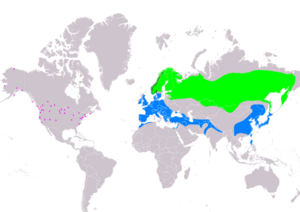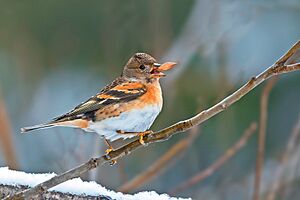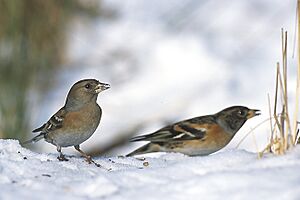Brambling facts for kids
Quick facts for kids Brambling |
|
|---|---|
 |
|
| Male in Poland | |
 |
|
| Female in England | |
| Conservation status | |
| Scientific classification | |
| Genus: |
Fringilla
|
| Species: |
montifringilla
|
 |
|
| Range of F. montifringilla Breeding Resident Non-breeding Vagrant (seasonality uncertain) | |
The Brambling (scientific name: Fringilla montifringilla) is a small passerine bird. It belongs to the finch family, just like your pet canary! People sometimes call it the 'cock o' the north' or the 'mountain finch'. These birds are found in many places and travel long distances. You can often see them gathering in very large groups.
Contents
About the Brambling's Name
The famous scientist Carl Linnaeus first described the Brambling in 1758. He gave it the scientific name Fringilla montifringilla. The word montifringilla comes from Latin. Mons means mountain, and fringilla means finch.
The English name "brambling" has been used for a long time. It was first written as "bramlyng" in 1544. We are not sure why it's called a brambling. It doesn't seem to be connected to the bramble plant (blackberry bush).
What Does a Brambling Look Like?
The Brambling is about the same size and shape as a common chaffinch. Male Bramblings look very special during breeding season. They have a black head, dark back, orange chest, and a white belly.
Female Bramblings and younger birds are not as colorful. They look more like some chaffinches. But even so, Bramblings have a few key differences from chaffinches:
- Bramblings have a white patch on their rump (their lower back). Chaffinches have a grey-green rump.
- The Brambling's chest is bright orange, and its belly is white. Chaffinches have more plain, even-colored undersides.
- Bramblings have orange scapular feathers (feathers on their shoulders). Chaffinches have grey or grey-brown ones.
- Bramblings have dark spots on their sides. Chaffinches have plain sides.
- Bramblings do not have white outer tail feathers, but common chaffinches do.
Another difference is the color of their beak. Most Bramblings have a yellow beak. Chaffinches usually have a dull pink beak. However, male Bramblings in breeding season have black beaks.
Brambling Measurements
- Length: About 16 centimeters (6.3 inches)
- Weight: 23 to 29 grams (0.8 to 1 ounce)
- Wingspan: 25 to 26 centimeters (9.8 to 10.2 inches)
Where Do Bramblings Live?
Bramblings live across northern Europe and Asia during their breeding season. They prefer to breed in open conifer (like pine or spruce) or birch woodlands.
These birds are migratory, meaning they travel far for winter. They spend winter in southern Europe, North Africa, northern India, northern Pakistan, China, and Japan. Sometimes, they even fly to Alaska and other parts of North America.
There are many Bramblings in the world, about 100 to 200 million. However, their numbers are slowly going down.
Brambling Migration Habits
Bramblings are almost always on the move. In Europe, they form huge groups in the winter. These flocks can have thousands or even millions of birds! Such big gatherings happen especially when there are lots of beech tree seeds (called beech mast).
Bramblings don't need beech seeds to survive winter. But these large winter flocks will keep moving until they find areas with plenty of them. This might be a way for them to avoid competing for food with common chaffinches.
Brambling Behavior and Life
How Bramblings Breed
Bramblings start having babies when they are one year old. They usually build their nests high up in a tree, close to the trunk. The female bird builds the nest. She uses things like lichen, grass, heather, cobwebs, and strips of bark from birch or juniper trees. She lines the inside with soft feathers, grass, and animal hair.
The female lays one egg each day. A typical nest has 5 to 7 eggs. The eggs can be light blue to dark olive-brown. They also have pink or rusty red spots. Each egg is about 19.4 by 14.5 millimeters and weighs about 2.14 grams.
The female sits on the eggs to keep them warm (this is called incubation). She starts after the last egg is laid. The eggs hatch after 11 to 12 days. Both parents feed and care for the young birds. The baby birds are ready to leave the nest after 13 to 14 days. Usually, Bramblings raise only one group of babies each year. But in some places, like northwest Russia, they might raise two.
Sometimes, other birds like the carrion crow and the Siberian jay might try to eat the eggs or baby birds. Also, the common cuckoo sometimes lays its eggs in a Brambling's nest, tricking the Bramblings into raising its young.
What Bramblings Eat
Bramblings change their diet with the seasons. In winter, they mostly eat seeds. But in the summer, they prefer to eat insects.




